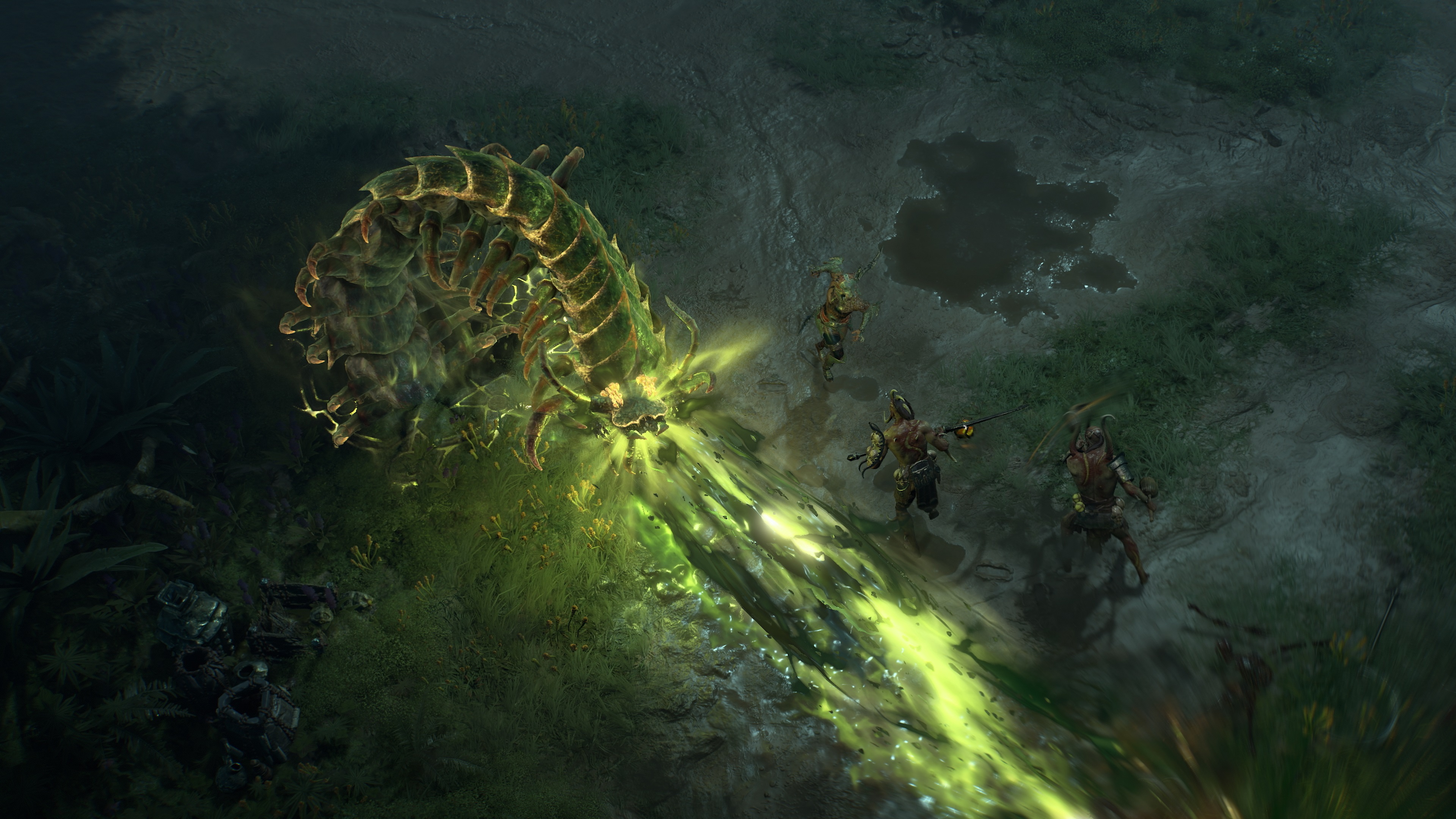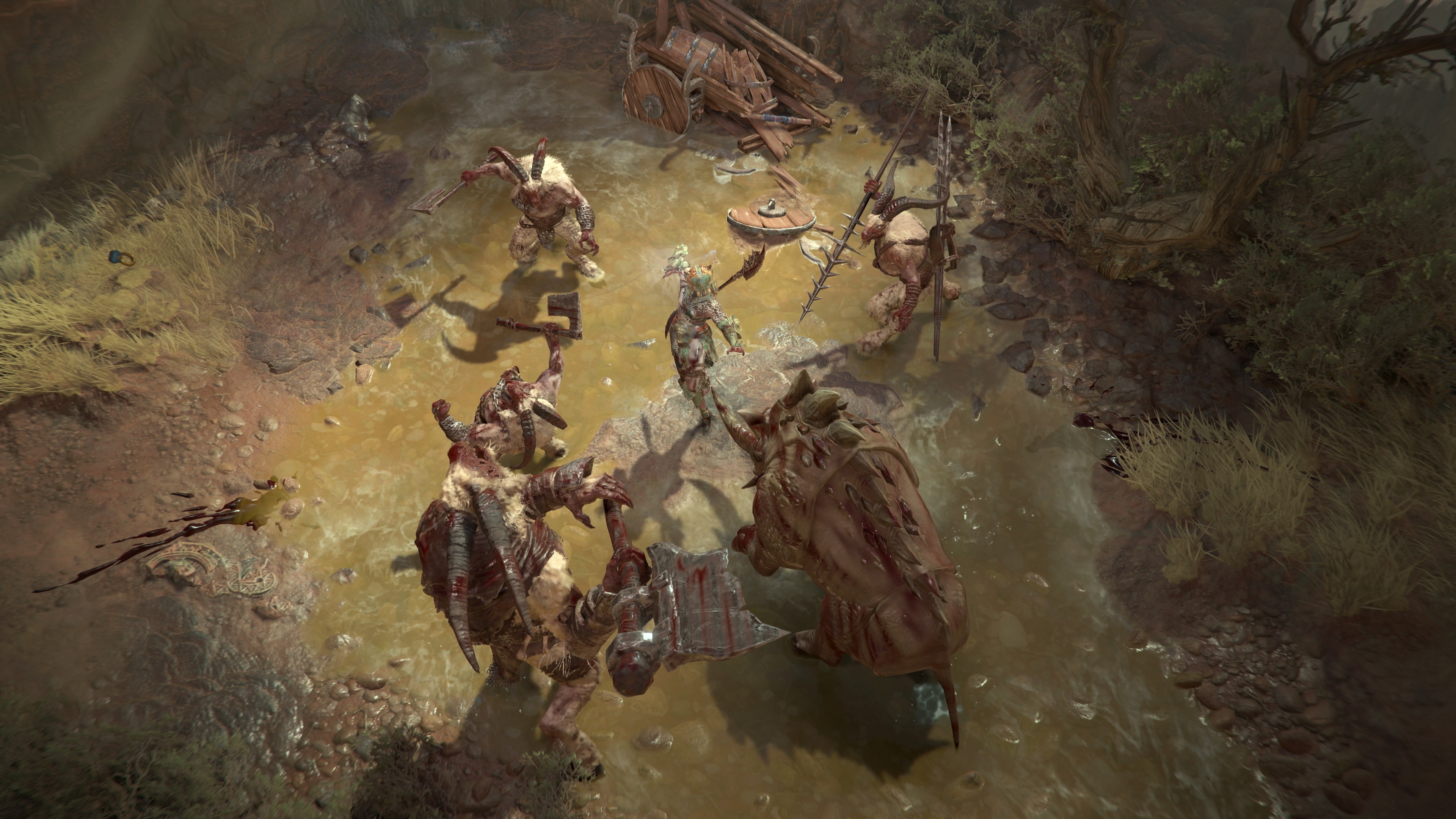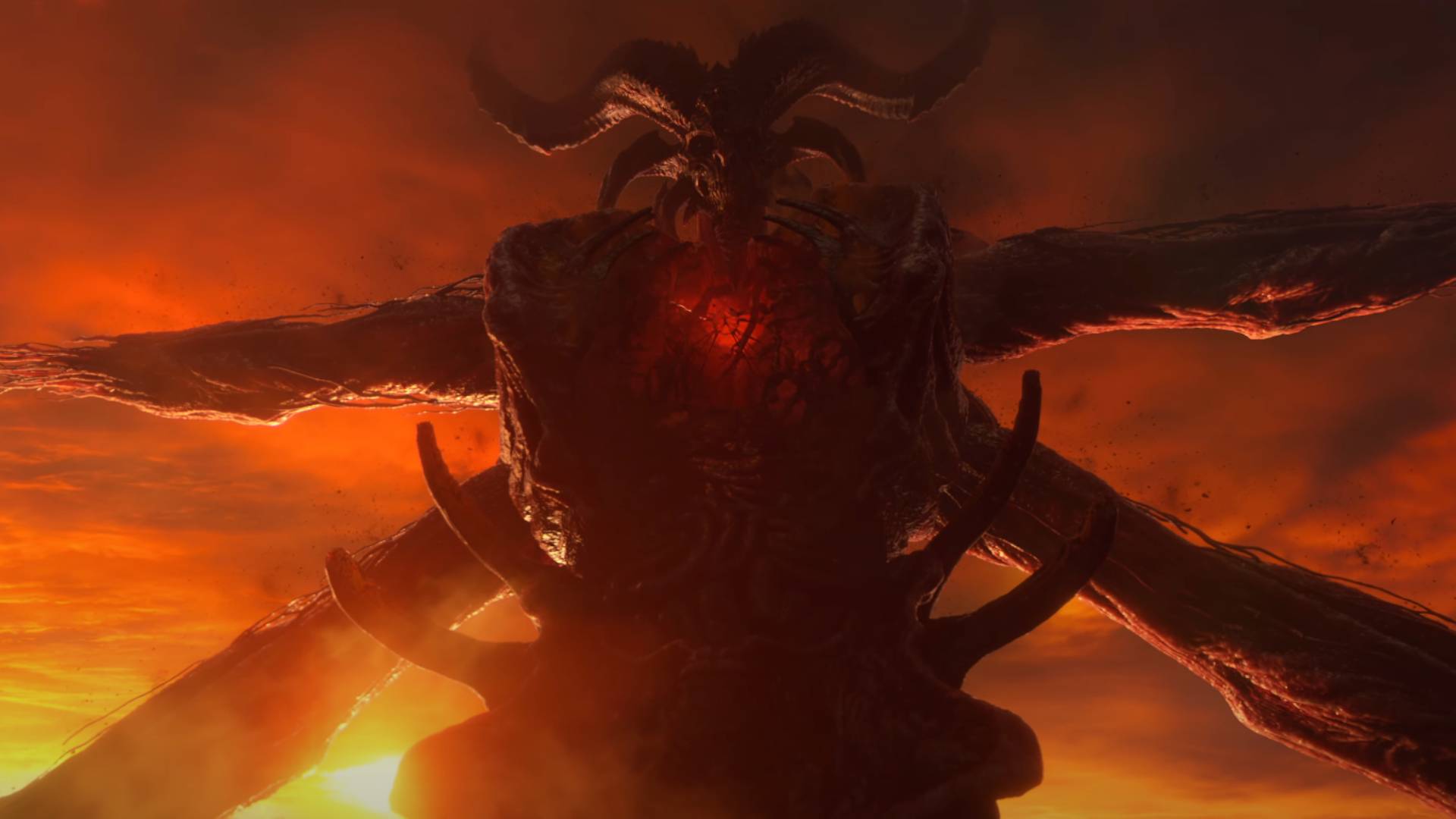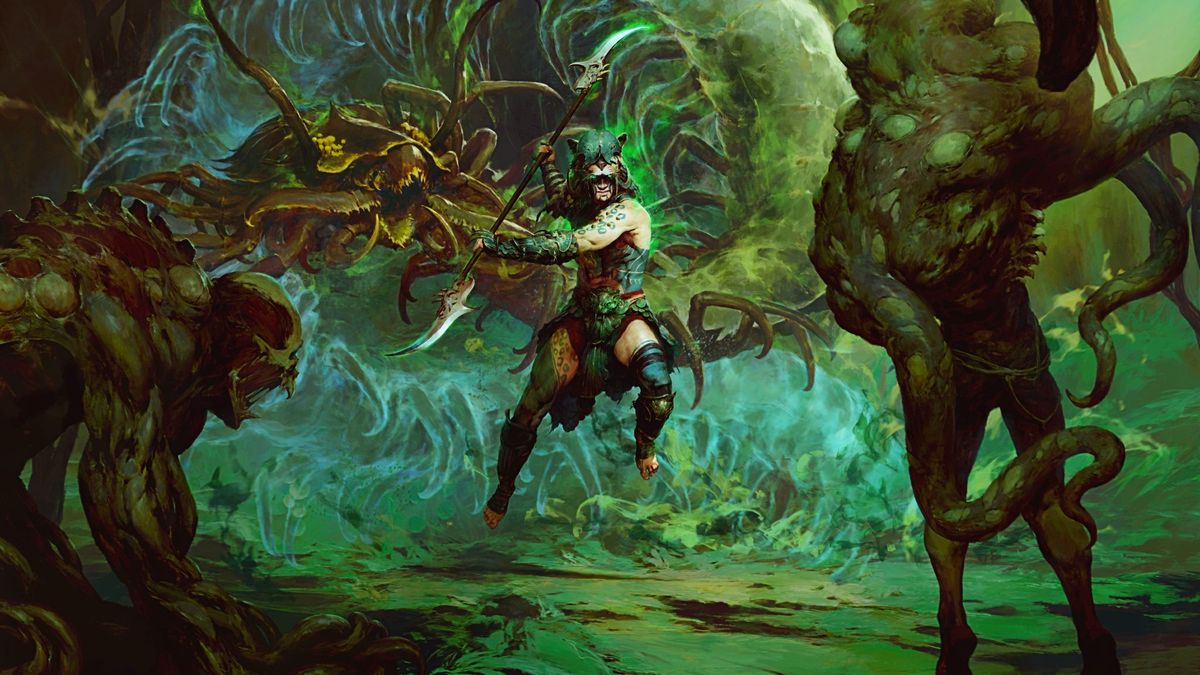Blizzard doesn’t often add a new class to Diablo’s ranks, but Vessel of Hatred’s Spiritborn swiftly makes the case for their introduction. The martial arts-styled warrior brings something new and seamless to the familiar sights of Nahantu while respecting a time-honored tradition of popping fleshy loot piñatas with reckless abandon.
Talking to the press at its California headquarters, Blizzard explains its approach to the Spiritborn’s lore is that the angels exist among the high heavens, the demons dwell deep within the burning hells, and we humans get the spirit realm in between – essentially a ghostly reflection of Sanctuary where spirits roam free. As a Spiritborn, you can manifest four of those spirits and bind them to your will.
If you’re wondering where they’ve been hiding all this time, the broad strokes are that the Nahantu natives chose to stay out of the fight that unfolded in Diablo 4 as memories of Mephisto still linger – his stone was held there during the events of Diablo 2, after all. Now that Neyrelle has brought the big brute back, remaining idle is no longer an option.
Born for this
This lore informs your chosen playstyle. The Spiritborn starts with one Spirit Guardian but can eventually utilize all four when far enough down the leveling path. The eagle lends itself to an agile and precise playstyle; the tanky gorilla is all about defense; the jaguar prizes aggression and multi-hit attacks; and the centipede is for fans of poison attacks and debuffs.
You’re free to chop and change skills as you please when putting your build together, though each spirit is color-coded to make it easier for those with less experience. Fancy putting together an eagle-focused build? Stick with the color blue.
While the Spiritborn is new, some spirits make them feel familiar. Playing Diablo 4 as a Rogue until now helps me feel at home with the kind of ‘glass cannon’ capabilities the eagle offers. Darting to mobs of foes and seeing them vanish in a maroon haze of lightning attacks scratches the same itch playing as my Rogue does. It’s not just the eagle, either – I’d wager fans of Diablo’s tankier classes will find plenty to love about the gorilla.
Be it Destiny 2’s Hunter or Diablo 4’s Rogue, I’ve always been one to pick the class that aesthetically hits the notes I like – sneaky assassins with cool cloaks, basically. The Spiritborn does not come with a cool cloak, as far as I know, but capturing what some of the rogues do best is enough to tempt me into breaking one of my worst RPG habits by actually making a new character who plays a different class.
Centipede main for life

Discussing how the Spiritborn came to be, game designer Bjorn Mikkelson explains that providing that sort of familiarity was the goal, as a good class offers something new, improved, and recognizable.
“What we were going for was this single character with multiple distinct fighting styles,” he says. “It’s partially just the nature of action RPGs – there aren’t actually that many types of fighting styles. You can only kill something in so many ways.”
Mikkelson goes on to say that the team tried to hit as many of those fighting styles as possible and was led by the idea that “what makes something successful is that there’s something recognizable versus something new.”
“We brought some of the slightly weird things out in the centipede, but there are still some recognizable elements there – if you’re used to damage over time, that sort of thing. So we expect some overlap, and really, what we’re going for is, ‘Hey, you can go all into that’ if that’s comfortable and fun for you. But the fun of Spiritborn is ‘maybe I can mix my Barbarian and Rogue together.’ That’s the hope we have for it.”
While Blizzard wanted the Spiritborn to feel familiar, it remained a chance for the developers to try some fresh ideas. Mikkelson says the centipede allowed the team to toy with some “strange and different” things. Fear debuffs, namely, are something we see across many RPGs but not a lot in Diablo 4’s base game.
As such, I ask if designing a new class is freeing, rather than remixing something we’ve seen before. While you can see plenty of Diablo 2’s Assassin and Diablo 3’s Demon Hunter in Diablo 4’s Rogue, the Spiritborn isn’t tied to as much history within the game’s universe. For Mikkelson, designing the Spiritborn was liberating, though he stresses that “freedom is sometimes a cage,” as whatever turns up still has to respect the boundaries set in Sanctuary.
The dev explains that the benefit of designing something like the Rogue is that most people know what it is and should be, but what the heck is a Spiritborn? Figuring it out from a gameplay perspective meant creating stuff that “didn’t make the cut” – though Mikkelson teases you may see some of that in the future – and fine-tuning through experimentation, with Blizzard making around 60 prototype skills “just to try out what feels fun and different.”
Back to Nahantu

What Blizzard could lean on, though, was Vessel of Hatred’s unfurling narrative. Going to Nahantu in Diablo 4’s first big expansion means returning to somewhere we know from Diablo 2 – the jungle. As such, most may have an idea of who the Spiritborn is roughly from where they live.
Associate narrative designer Eleni Rivera-Colon tells us that, while the narrative team wanted to “restructure” what it means to return to the old locale, it’s the “perfect time” to introduce a new class that truly fits into the setting – rather than bringing back something you’ve seen before that might fit less so. The narrative team also enjoyed the sense of freedom to figure out what that all meant, though we know by now what that freedom can feel like.
“I think it was freeing for the team, as a whole, to get to try new stuff,” Mikkelson says before Rivera-Colon adds, “All while fitting into the Diablo theme and lore and making sure that whatever class it is that’s being created, doesn’t feel like you’re breaking the fantasy of what Diablo 4 is, right?
“Because I think that’s important to our player base,” she continues. “Even if you’re coming into it new, throwing something so far off feels jarring. And it takes you out of everything in the story that we’ve been building.”
Referring to what Mikkelson said earlier about freedom being a cage, Rivera-Colon adds, “That’s the cage, right? The cage is making sure that it still fits within the construct and the expectations for players at the same time.”
The story so far

As Vessel of Hatred approaches, Diablo 4 finds itself in a much healthier position than it did at launch. While the loot ’em up showed promise at launch, the first few seasons went back and forth among fans’ expectations until the fourth season’s loot overhaul placed the game on better footing.
While the main game’s development largely unfolds alongside those working on the DLC, the vibe remains positive that Diablo 4 is getting better and better as Vessel of Hatred nears. And that’s good for everyone.
“The changes that have happened are obviously coming from a place of learning and trying to improve the game,” Mikkelson says. “But, you know, we’re also always doing that with the mind towards wanting the game in a good spot when we’re going to add a whole bunch of new stuff to it. So I think, largely, with each iteration, we’re happier and happier with where we’re at.”
Rivera-Colon adds, “At the end of the day, we want people to want to play Seasons, but we also want them to enjoy Vessel of Hatred and the Spiritborn class. So it’s a combination of making sure that they’re enjoying the game so they can trust us when it comes to the expansion and introducing a new class. And they can say, ‘Okay, they finally hit their stride, and now we’re going to be able to trust that there’s going to be something cool coming up next.”

